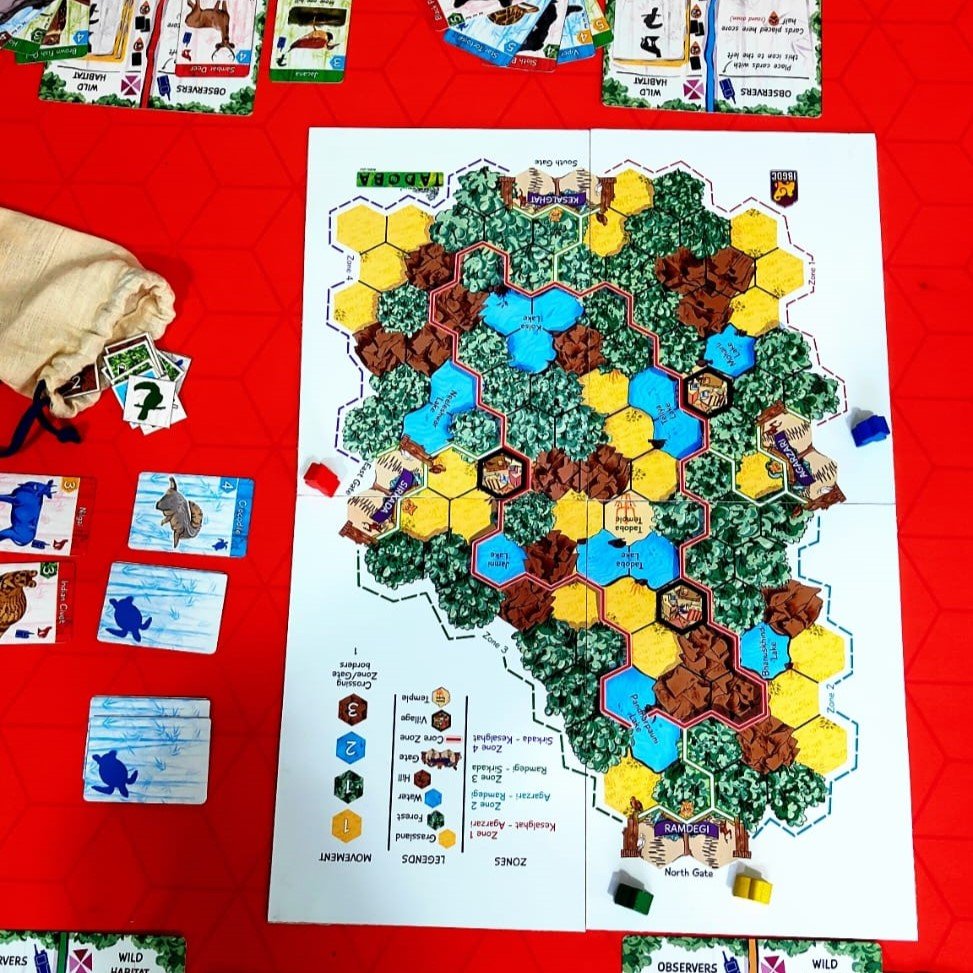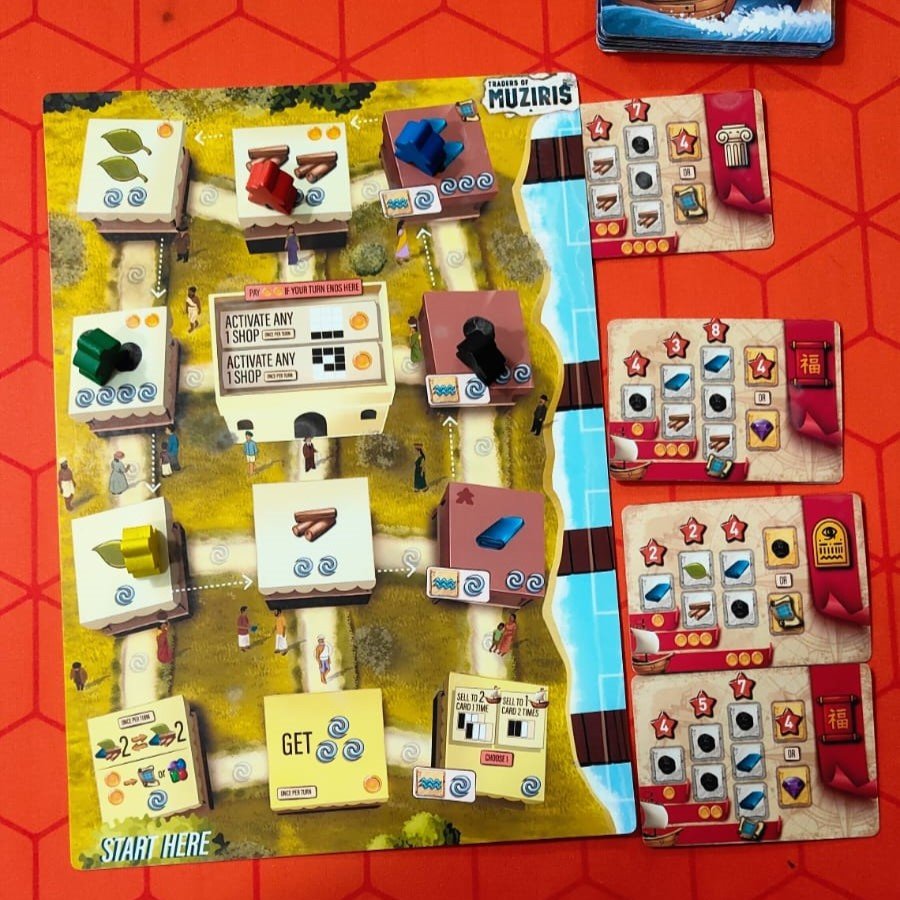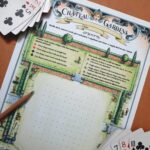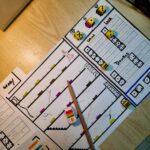Sinauli Unearthed
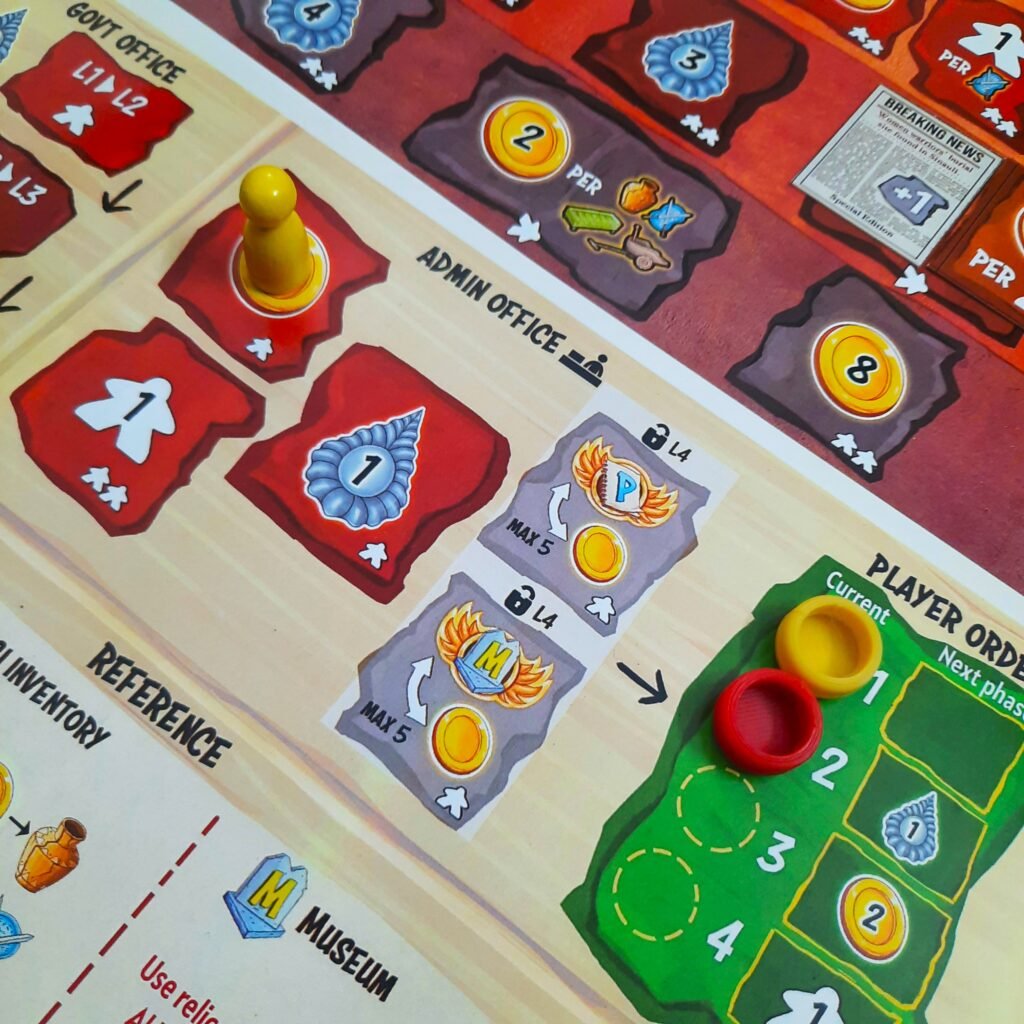
The dust of history stirs beneath your boots…
You’ve just arrived in Sinauli, a quiet corner of North India that holds echoes of the ancient Harappan Civilization. But this isn’t just another dig site. It’s a battlefield of legacies…
As you brush away the soil, fragments of a forgotten world begin to surface. Each relic holds a story, but what you choose to do with it is entirely your call.
Will you race to publish your findings, win over museum curators, or build political clout in the corridors of Delhi, in pursuit of the prestigious Bharat Ratna Award?
My friends used to joke that I time-traveled from one of the ancient civilizations, likely Egyptian. When I was young, I used to get lost in the documentaries of lost civilizations on National Geographic, which later transitioned to more action-packed movies with less history and more drama (i.e., The Mummy series).
I came across Sinauli Unearthed on Kickstarter a few months ago, and my curiosity instantly kicked in. Knowing about the 4000-year-old burial site discovered in 2005, both the place and the game had my full attention. I was thrilled when Sidhant Chand reached out to let me try the game. He’s one of the founding members of the Indian Board Game Designers Collective (IBGDC), the team behind Sinauli’s Kickstarter launch.
First Impressions
My last journey through an ancient realm was with Hieroglyph Historians, a game that trapped me inside a tomb and challenged me to escape using my knowledge of hieroglyphs. Since Sinauli Unearthed also dives into a lost civilization, I expected a similar experience. But to my surprise, it didn’t!
Sinauli Unearthed puts you in the shoes of a modern-day archaeologist. You are not only discovering the past, but also competing for recognition, influence, and a prestigious award. So, in a way, the game sounds real! And less glamorizing of the past, like a blockbuster.
It’s a game designed by Neha Mittal, and illustrated by Amit Ghadge, that can be played by 2 to 4 players in the space of an hour.
So I put my excavator’s cap on and cracked on!
Questions that lingered in my ancient mind before trying the game:
+ What’s the ideal player number for Sinauli Unearthed?
+ How much will luck play a part in the game?
+ With such an interesting story behind the game, how well does it blend with the mechanics?
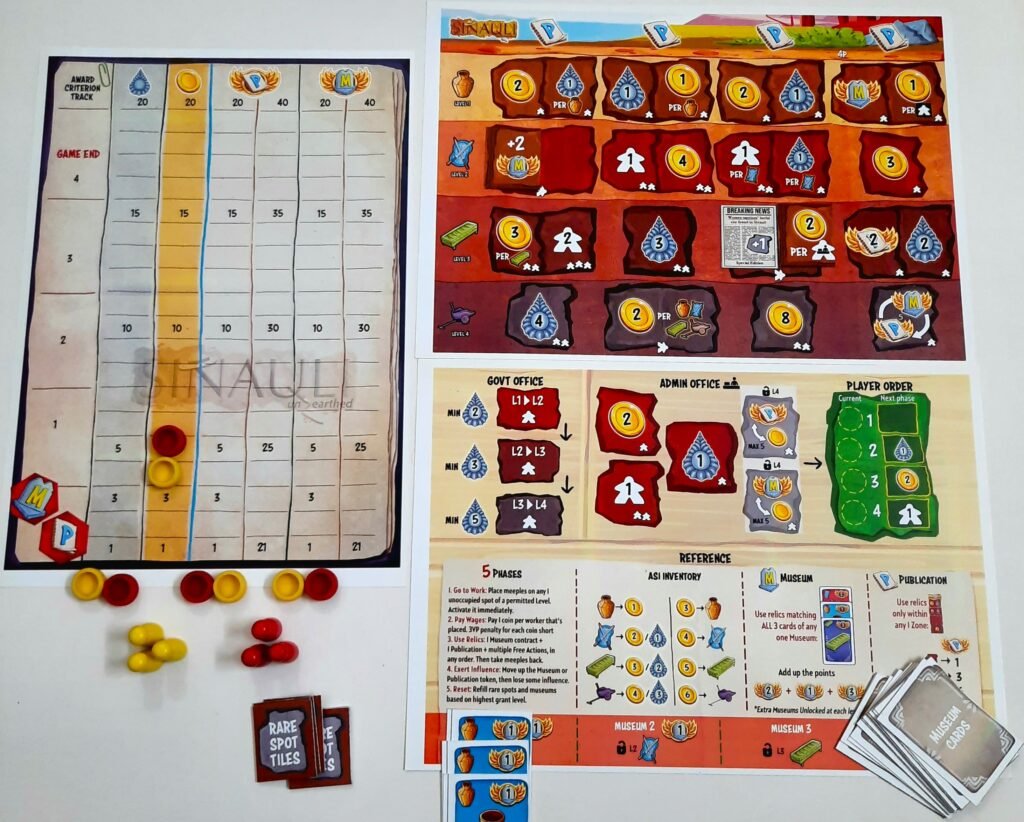
Preparing the game
You start off by printing the game files in color, which have 7 pages in total. Out of those, 3 pages need no assembling: the Score Board, Soil Board, and the Support Board.
The remaining 4 pages need to be cut and assembled into the 16 Museum Cards, 12 Rare Spot Tiles, 2 Newspaper Articles, 1 Publication Token, and 1 Museum Token. The only additional elements that you need alongside what the game files provide are 6 Meeples per player and 7 cubes/markers per player. They must be distinguishable by color.
There’s no writing involved in the game; all the cards, tokens, and markers will be placed on the various places of the 3 boards throughout the game.
No dice? That’s right. This game might lean more on strategy than luck.
Findings
Paving your path in a layered game
There’s no automa in the game that will prompt you to be in places; you make your own moves. On every round, you will have at least three Meeples to occupy spots on the boards which leads you to earn coins, influence, or dig relics from the soil board. And how you earn points is really up to you. There aren’t unlimited spots up for grabs as you compete with other players, so timing becomes a crucial part of the game.
What I really enjoyed is how each step you take holds weight. At first, I was going mainly for gold coins just because they were easy to earn, but I soon realized how I should prioritize the influence points, without which I cannot proceed to higher levels on the Soil Board.
And it’s because of these levels, you cannot be all over the boards! You need government permission to enter higher levels, and that can only be attained once you have a designated influence point. Having the entire experience divided into layers helped me strategize it better, and also to compare performances among fellow archaeologists.
Tying up story with game mechanics
As much as a game needs a good narrative, its integration with game mechanics is crucial to its effectiveness. The goal of Sinauli Unearthed is to make players feel like archaeologists building their legacy, and from my experience, it succeeds in doing just that.
How so?
+ You are digging out relics on each round, with access to deeper levels granted by the government as you reach higher levels.
+ You deposit or buy relics from the ASI (Archaeological Survey of India) inventory.
+ Based on the relics you dug out, you can fulfill museum contracts and also publish your findings in famous archaeological publications to earn points.
+ Every round of the game ends with the player with the highest influence point choosing either the Museum or Publication token and moving it up by 1 level. The game ends when either token reaches level 4, and the criterion for the Bharat Ratna Award is based on whichever one gets there first. In other words the players, rather the influential ones, are getting to choose the criteria for the winner of the game.
Sinauli Unearthed successfully translates its unique narrative into the game mechanics, and not once did I feel removed from the role of an archaeologist in a competitive world. The game made sure of that!
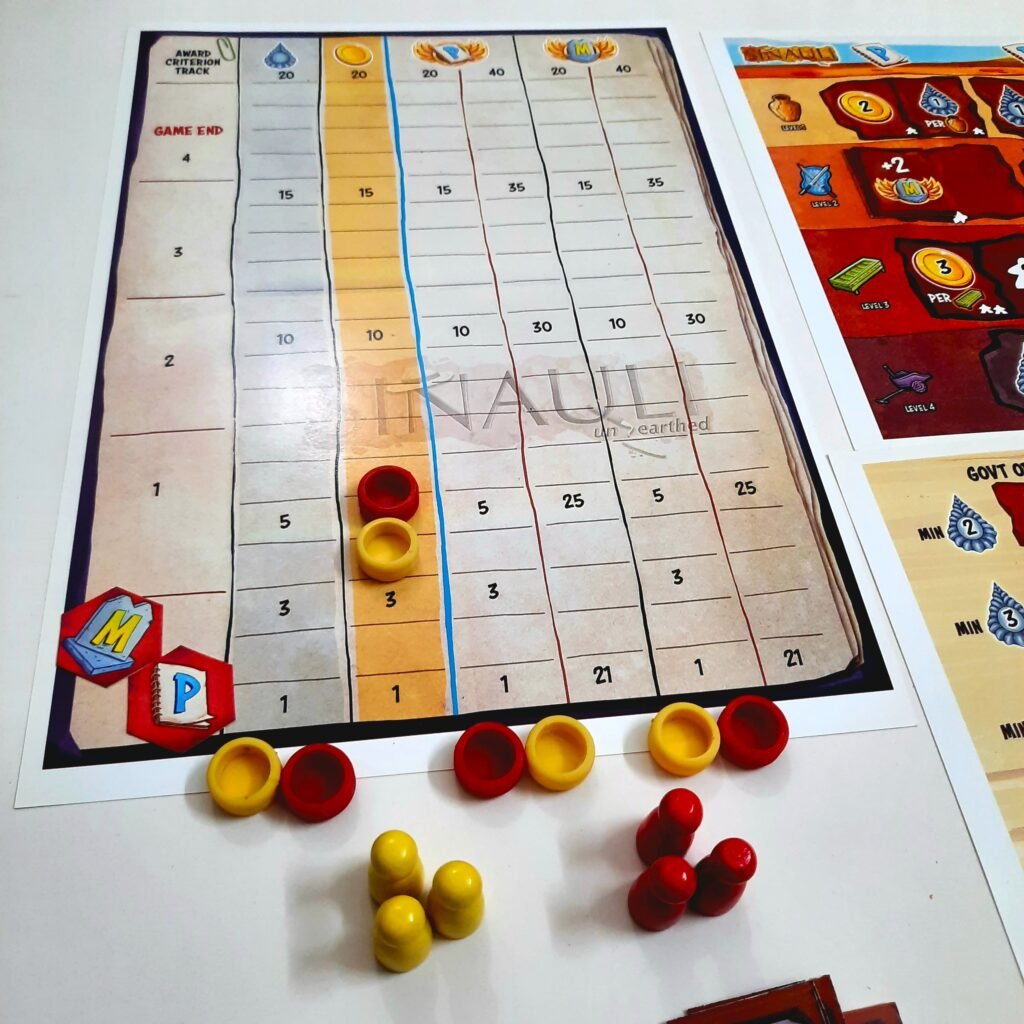
Mechanisms that stood out for me
Alongside its unique narrative approach, which views the game through the lens of competitive archaeologists, these are the mechanisms that stood out to me:
+ The order of placing meeples: You don’t deploy all your meeples at once; rather, one at a time. This opens the door to strategy as you gradually place your meeples with your opponents and try to pick the best spots for yourself.
+ The ever-changing turn order: Unlike most multiplayer games, turn order in this one isn’t fixed; it changes every round, creating a more balanced and dynamic experience.
+ Players own the winning criteria: There are multiple paths to victory, and it’s your call to pick one if you play it smart!
Preferred player count
I’m still in the early days of playing the game, but I really enjoyed the 2 and 3-player modes. With 4 players, we were often competing for the same spots, while the 2-player mode offered plenty of options.
3 might just be the sweet spot for this game. 2 is also a great way to start. That said, I’m still exploring, and with more experience, I might end up enjoying the 4-player mode just as much.
Not one but three!
If you’ve liked reading my take about Sinauli Unearthed, then you’re in for a delight! The Kickstarter campaign for the game also includes 2 games: Tadoba and Muziris.
Tadoba: Wildlife Safari
In Tadoba, players explore the dense jungles of India’s renowned Tadoba Tiger Reserve, rolling dice to explore a vibrant hex-based map filled with forests, hills, and reservoirs.
As they navigate the terrain, players reveal hidden Spotting Tokens that trigger critter sightings or false alarms, adding moments of surprise and tension. The collected critter cards, including birds, reptiles, and mammals, are placed into zones of the Field Guide such as Photography, Jungle Diaries, Observers, or secret Wild Habitats. Each zone scores differently and grants unique bonuses.
Traders of Muziris
Step into the shoes of a master merchant in Traders of Muziris, a vibrant game set in the thriving port city of ancient Kerala.
Across nine rounds, players explore a lively board of shops and harbors, spending action points to move, acquire exotic goods like pepper and silk, and fulfill contracts for ships docked at the port. Each completed contract unlocks blueprints, gemstones, and flags that boost your prestige and final score. But watch out, the crowd pawn can block crucial shops, challenging you to adapt your strategy.
The campaign is underway!
It’s only been a couple of days since the campaign for the 3 games launched, and it’s off to a spectacular start! So if you want to bring three unique experiences to your gaming table, you know exactly what to do!
Recommended items
Game Overview
Publisher: IBDGC
Designer: Neha Mittal
Artist: Amit Ghadge
Number of players: 2 to 4
Difficulty level: Easy to Medium
Rounds of gameplay needed to learn: 1 to 2 rounds
Game duration: 40-50 minutes
Available on: Kickstarter
Theme: Worker placement | Variable turn order
Number of pages and color: 7 (color print)
Assembling difficulty level: Basic. Cutting/sleeving the cards and tokens (both-sided)
Lamination: Recommended for longevity for the 3 boards in the game
Additional elements required: 6 meeples + 7 markers per player
Time to learn: Within 30 minutes
Travel-friendly: 9/10
Shelving friendly: 9/10
Rating from PnP Time: 8.5/10

Tasliman is a board game developer based in Bangladesh, with the dream of exploring the world of games and introducing it to anyone new to it. He is the founder of Kraftz, a brand that develops board games commercially, as well as with reputed entities like BRAC and The Gates Foundation.

